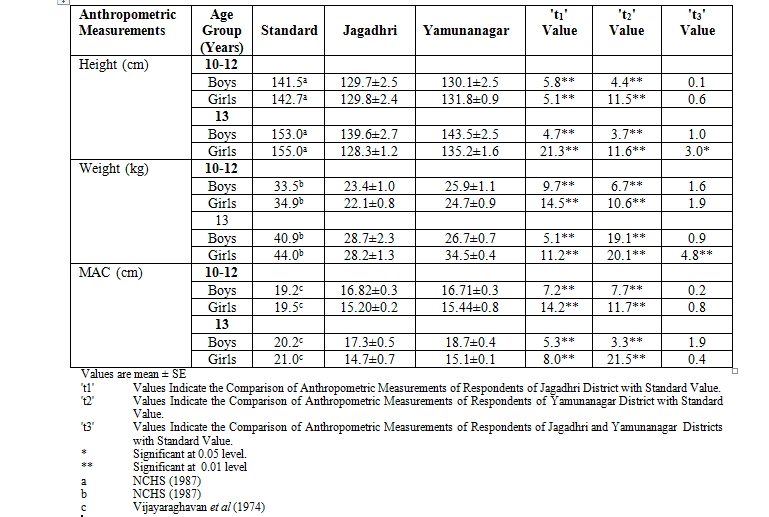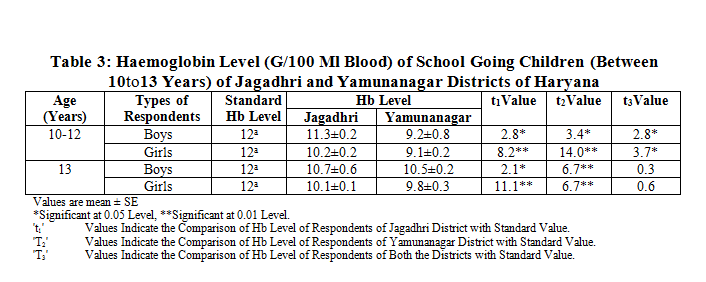Alleviation: An International Journal of Nutrition, Gender & Social Development, ISSN 2348-9340
Volume 2, Number 2 (2015) : 1-7
©Arya PG College, Panipat & Business Press India Publication, Delhi
www.aryapgcollege.com, www.apcjournals.com
A Study of the Health Status of Children
Abha Khetarpal
Department of Home Science, DAV College, Yamunanagar (Haryana), India
E-mail: abhakhetarpa@rediffmail.com
Introduction
Children play an important role in the development of nation as they are the future of any country. The development potential of society depends upon the level of physical and mental state of its young population for which childhood lays the foundation and nutrition is an important determinant of the quality and strength of this foundation. Growth and development depend on nutrition to support physiological and metabolic process of the body and the consequently the nutritional status of school going children is profoundly influenced by the diet consumed by them (Rao et al 1984). Malnutrition during critical period of growth leads not only to the stunting of physical growth but also to suboptimal intellectual development. Nutritional deficiencies may not Necessarily be due to the deficiency of more than one nutrient in the diet taken currently for considerable period of time. The deficiency of one or more nutrients may produce different diseases in accordance with varying degrees of deficiencies of nutrients, human resistance and variable climatic conditions. Hence, diet and nutrition surveys conducted from time to time on various section of the population prove very useful to the policy makers so as to formulate policies and programmes to curb malnutrition in time. Keeping it in view, a survey of school going children residing in Yamunanagar and jagadhri districts of Haryana was conducted to assess their nutritional status.
Material and Methods
Yamunanagar and Jagadhri districts of Haryana were selected purposively to carry out the present investigation. For anthropometric measurements, data regarding height, weight and mid-arm circumference of the selected children were collected (Jellife 1966). Mean height and weight values were compared with standards of NCHS (1987) and the values for mid-arm circumference were compared with standards of Vijayaraghavan et al (1974).
The body mass index was calculated using the equation given by Garrow (1981)

The haemoglobin level of subjects was estimated by using Sahil type of clinical haemoglobinometer (Oser 1954). Values were compared with the standards of WHO (1989). The data were subjected to statistical analysis using standard methods.
Results and Discussion
Anthropometric Measurements of School Going Children of Jagadhri and Yamunanagar Districts of Haryana
Height: The mean height of boys (Between10 to 12 years) was 129.7 cm and 130.1 cm and of girls 129.8 and 131.8 cm in Jagadhri and Yamunanagar districts, respectively (Table 1). Height of both the genders in both the districts was significantly (p<0.05) less when compared to the standard values of NCHS (1987). However, the height of girls as well as Boys (Between 10 to 12 years) belonging to both the districts did not differ significantly (p<0.05) among themselves. Mean height of boys (13 years) was 139.6 cm and 143.5 cmand of girls (13 years) was 128.3 cm and 135.2 cm in Jagadhri and Yamunanagar
Table 1: Anthropometric Measurements of School Going Children of Jagadhri and Yamunanagar Districts of Haryana

districts, respectively. The girls of 13 years belonging to Yamunanagar district were significantly (p<0.05) taller than those belonging to Jagadhri district and such differences were noticed among the boys also. The boys as well as girls of this age group in both the districts had significantly (p<0.05) less weight than the standard values (NCHS 1987). Similar findings among the school children have been noticed earlier too (Verma and Bajaj 1985 and Chandana 1993).
Weight: Boys and Girls (Between 10 to 12 years) belonging to Jagadhri district had 23.4 kg and 22.1 kg body weight, respectively, whereas those belonging to Yamunanagar district had 25.9 kg and 24.7 kg, respectively (Table 1). On the whole significant (p<0.05) differences in weight were not observed among the children of these two districts.
In the age group of 13 years, there were not significant variation among the weights of boys belonging to Yamunanagar and Jagadhri districts but girls of Yamunanagar district had significantly (p<0.05) more weight than those belonging to Jagadhri district. However, boys and girls of both the age groups and belonging to both the districts had significantly (p<0.05) less body weight when compared to those of standards of NCHS values. Less body weight may be due to less intake of various food groups. The diets of the respondents of both the districts were deficient in energy, protein and iron. Istomin and Mikhailov (1997) reported that the daily intakes of protein, fat and carbohydrates were below normal requirement in school children of Murmansk region, Russia. About 3 per cent of school children suffered from chronic under-nutrition (Tena-Flores and Frisanche 1997). Lower body weight and height among the school going children than the reference values were also reported in many previous studies (Chandana 1993 and Bhatia 1996). On the contrary, higher body weight and height have been reported by some other researchers (Bhasin et al 1990, Yaima and Narendra 1992).
Mid arm circumference: Mid arm circumference of boys as well as girls of both the age groups was significantly less than the standard values in Jagadhri as well as Yamunanagar districts (p<0.05)(Table 1). It can be observed from the data that there were no significant variations in the mid arm circumference of these children belonging to both the districts. Poor nourishment of children may be contributing towards the low values of MAC than the standard values. These findings are in agreement with other researchers (Lakhmi and Rao 1988, Chandana 1993, and Goyal 1994).
Body Mass Index (BMI) kg/m2of School Going Children (Between 10to13 Years) of Jagadhri and Yamunanagar Districts of Haryana The mean BMI values for boys in the age group between 10 to 12 years and 13 years were 13.8 and 14.5 in Jagadhri and 15.3 and 13.2 in Yamunanagar district, respectively (Table 2). The BMI values of boys and girls belonging to these two age groups in both the districts did not differ significantly (p<0.05). The observed BMI values among boys as well as girls were below the normal BMI values i.e. 20 to 25, above which obesity starts (Garrow 1981). Similar findings are also reported earlier (Sood 1992, Bhatia 1996 and Thumbi 1993).

In the age group between 10 to 12 years, the levels of haemoglobin values of boys as well as girls were significantly (p<0.05) less than the standard values in both the districts. Boys as well girls belonging to Yamunanagar district had significantly less haemoglobin level than those belonging to Jagadhri district which is due to less intake of iron rich foods especially green leafy vegetables and fruits (p<0.05) (Table 3).
Boys and girls of 13 years in both the districts had significantly less haemoglobin level than the standard values (p<0.05). However, haemoglobin levels of boys as well as girls belonging to Jagadhri district did not differ significantly from those of children belonging to Yamunanagar district. The lower levels of haemoglobin of boys as well girls belonging to both districts may be due to fewer intakes of iron rich foods. The results of present investigation are in accordance with those of earlier work (Chandana 1993 & Goyal 1994).

Conclusions
The need of the hour is to impart nutrition education to the parents so that the nutritional status of the children could be raised. The children should be given a balanced diet. The diet should be rich in proteins, energy, minerals and vitamins. The children should take more of milk and milk products, soyabean, tofu, vegetables and fruits. They should developpositive attitude in life and should study hard but must keep aside some time for enjoyment.
References
Bhatia P (1996) Nutritional Status of Adolescent Girls in Irrigated and Unirrigated Areas of Hisar District, M.Sc. Thesis CCSHAU, Hisar.
Chandana S (1993) Nutritional Status of School Going Children (6-12 Years) of Panipat City with Special Reference to Vitamin A. M. Sc. Thesis, CCSHAU, Hisar.
GarrowJS (1981) Treat Obesity Seriously: A Clinical Manual. Livingstone: Edinburg Churchill.
Goyal J (1994) Nutritional Status of School Going Children in Rural Areas of Rohtak District.M.Sc. Thesis, CCSHAU, Hisar.
Istomin AV and Mikhailov IG (1997) Hygienic Evaluation of the Indicators of Nutritional State of School Children of Monchegorsk. NAR (Series A) 68 (4) : 416.
Jelliffee DB (1966) The Assessment of the Nutritional Status of the Community WHO Monograph Series No. 53, Geneva.
National Centre for Health Statistics (1987) Anthropometric Reference Data and Prevalence of Overweight.US1976-80, Vital and Health Statistics, Series 11, No. 238, DHHS.Pub. No. (PHS): 87-1688.
Oser BL (1954) Hawk's Physiological Chemistry. Bombay: Tata Mc Grow. Hill Pub. Co. Ltd.
Tena-flores, JA and Frisancho, AR (1997) Anthropometric Growth of School Population in Rural and Sub-Urban Areas of Durango, Mexico. NAR (Series A) 68(2): 196.
Thumbi ZA (1993) A Study on the Effects of Iodized Salt on the Iodine Status and Prevalence of IDD among Pre-Adolescents.Seminar on Prevention and Control of Iodine Deficiency Disorders. SNDT Women's University Bombay: 46-55.
Verma S and Bajaj S (1985) Nutritional Profile of School Children. Proc. Nutr. Soc. India 31:101-102.
Vijayraghavan K, Singh D and Swaminathan MC (1974) Arm Circumference and Fat Fold at Triceps in Well Nourished Indian School Children. Ind J Med Res 62: 994–1001.

